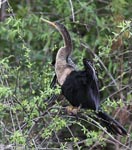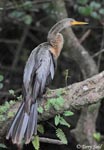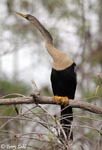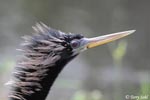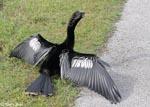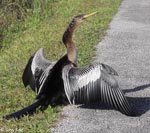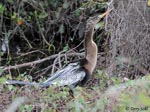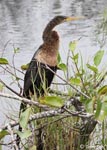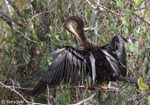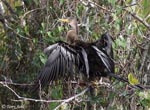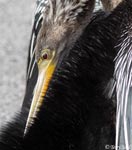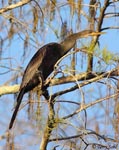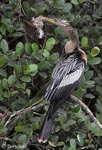Anhinga
Anhinga anhinga
| Length: 35 inches | Wingspan: 45 inches | Seasonality: Non-resident in South Dakota |
| ID Keys: Unique if seen well, long skinny neck, long sharp orangish bill, dark overall, white on wings | ||
 The
Anhinga is an unusual resident of the southeastern U.S., with a range that
extends southward through Mexico, Central America, and into northern South
America. They are the only representative of the Darter family in the
western Hemisphere. Unlike most waterbirds, their feathers become
waterlogged when swimming and foraging. As a result, Anhingas are
often seen in the classic pose seen in the photo to the right, perched on a
dead snag with wings extended for drying. They are equally at home in
the air as they are in the water, as Anhingas are very strong fliers and are
often seen soaring and gliding like a vulture or other raptor.
The
Anhinga is an unusual resident of the southeastern U.S., with a range that
extends southward through Mexico, Central America, and into northern South
America. They are the only representative of the Darter family in the
western Hemisphere. Unlike most waterbirds, their feathers become
waterlogged when swimming and foraging. As a result, Anhingas are
often seen in the classic pose seen in the photo to the right, perched on a
dead snag with wings extended for drying. They are equally at home in
the air as they are in the water, as Anhingas are very strong fliers and are
often seen soaring and gliding like a vulture or other raptor.
Habitat: Most often found on lakes or slow-moving rivers with surrounding trees, such as cypress swamps, mangroves, or reservoirs with standing dead trees. Despite their range near the southeastern U.S. coastline, they are nearly always found in freshwater habitats.
Diet: Most of the diet is fish, but they will also feed on a variety of other prey, including crayfish, large aquatic insects, shrimp, frogs, and small snakes.
Behavior: Often forages by patiently waiting on a perch or while swimming in the water, waiting for a fish to pass close by. When prey is spotted, it is speared with quick thrush of the neck and sharp bill.
Nesting: Anhingas most often nest in colonies, often mixed colonies with other water birds such as herons, egrets, and cormorants. The nest is a large platform of sticks, sometimes lined with leaves or other softer vegetative material. Both the males and females help to incubate the eggs, and both parents help to raise the young.
Interactive eBird Map: Click to access an interactive eBird map of Anhinga sightings.
Song: Anhingas are often quite vocal, making a variety of croaking, grunting, and clicking sounds.
Migration: Most birds in the northern part of their range (most U.S. birds) migrate southward in the fall, moving to Mexico. Some birds do stay in the U.S. for the winter though, primarily in southern Florida or along the south Texas coast.
Similar Species: Most often confused with Cormorant species, but distinctive from Cormorants if seen well.
Conservation Status: There are currently no perceived major threats to Anhinga populations, and Birdlife International cites it as a species of "Least Concern".
Further Information: 1) Cornell's All About Birds - Anhinga
2) Florida Nature.org - Anhinga
3) AvianWeb - Anhinga
Photo Information: Photo taken on December 10th, 2012 - Big Cypress National Reserve in Florida - Terry Sohl
| Click below for a higher-resolution map |
 |
| South Dakota Status: Non-resident in South Dakota |
Additional Anhinga Photos
Click for a higher-resolution version of these photos
